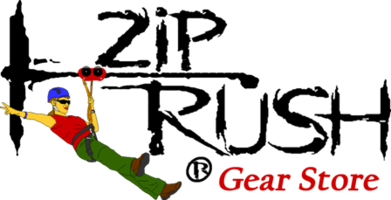Use the following table as a rule of thumb to determine the size of your cable according to it's length and the rider's weight you want to put on the zipline. Then, choose the turnbuckle and the amount of wire clips accordingly.
| Length | Max Rider Weight | Cable | Turnbuckle | # Clips |
| up to 100' | 100 lbs | 1/4" | 1/2" | 3 |
| up to 500' | 250 lbs | 5/16" | 5/8" | 3 |
| 500' and up | 350 lbs | 3/8" | 3/4" | 3 |
*Certain short zipline can generate more tension than others much longer. Ask us for a free catenary and tension study and avoid a bad surprise. We do not make ourselves responsible for an overloaded cable or for any other aspect of your backyard zipline. Seek professional help to install your zipline
CABLE: First you need to purchase a cable. Size should be determine using the preceding chart.
TREE WRAP:Wrap a cable sling around you first tree (always use same size sling or bigger than your zipline cable)
TURNBUCKLE: Open your turnbuckle completely and attach it to your cable sling
BACK-UP: (coming soon) Add an optional turnbuckle back-up cable for your peace of mind (you will need 3 more wire clips)
WIRE CLIPS: Attach you cable to the other end of the turnbuckle. If you purchase the cable with us, you will already have an eye termination built in your cable. If you don't, you will need at least 3 forged wire clips and a thimble. CAUTION: Do not use malleable wire clips for zipline cables; this is a dangerous practice. You need a quality forged wire clip for this purpose.
TENSION KIT: Pull you cable to the other tree and tension it. If your zipline has a low clearance, you may need a tension kit. Once you cable is under tension, you will need, again, a minimum of 3 wire clips to securely attach it around the tree.
ZIPLINE BRAKE: In most cases, you will need to install a zipline brake because to hit a tree is not a very good way to stop. You can use a brake block with a rope you will manually control or a brake block with a bungee cords attached to an anchor.
ZIPLINE PULLEY: You are now ready to zip down! Choose a trolley that will meet your goals and respect your budget.
ZIPLINE SEAT: Use a zipline seat for more comfort and enhanced safety
HARNESS: Use a harness if you zipline travel over 10 ft at any point of the span
LANYARDS: If you use a harness, you will also need a 30 cm lanyard to attach to the pulley... and you may consider a 45 cm back up for your peace of mind.
CARABINERS: Add 1 carabiner for the short lanyard, and another one for the back-up if they are not included in an harness kit
HELMET: Finally, if you care about safety, wear a helmet and keep your ideas intact.

Looking to build a Zipline that end in the water. I will drill a 2" steel pole into the rock that is 12" below the water. It should hold up to 250lb but it is really designed for my grandson. I can take picture and offer measurements for you if you wish. this will be located at our cottage in Honey harbour on Georgian Bay